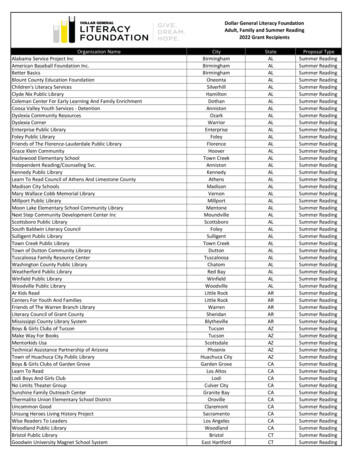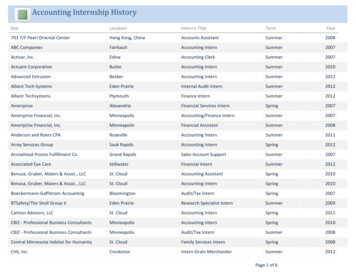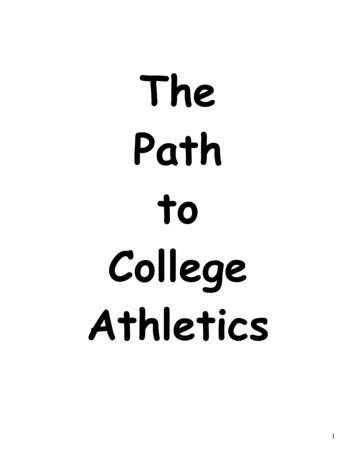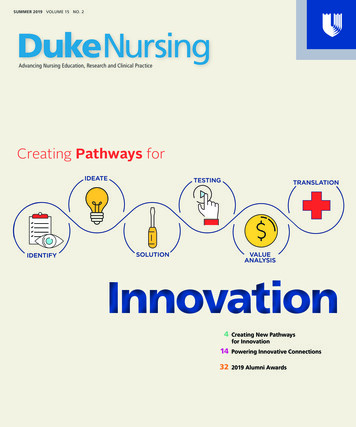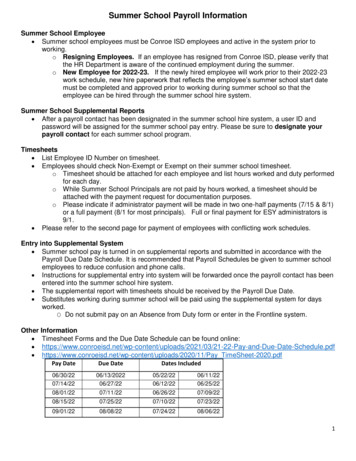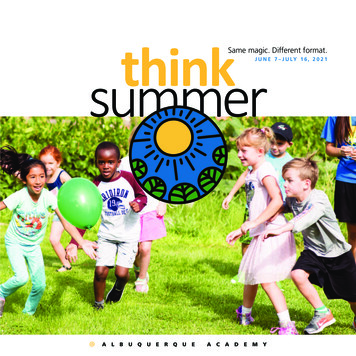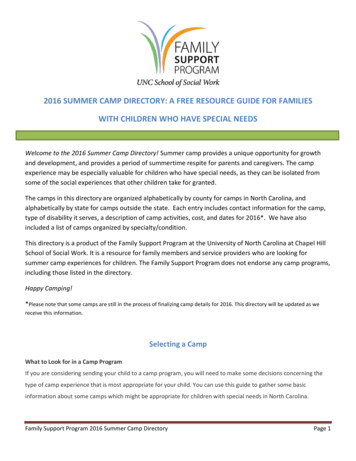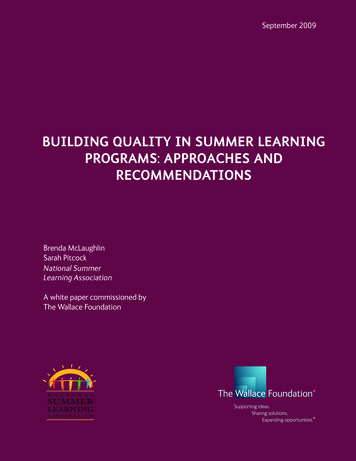
Transcription
September 2009BUILDING QUALITY IN SUMMER LEARNINGPROGRAMS: APPROACHES ANDRECOMMENDATIONSBrenda McLaughlinSarah PitcockNational SummerLearning AssociationA white paper commissioned byThe Wallace Foundation
Building Quality in Summer Learning Programs:Approaches and RecommendationsBrenda McLaughlin and Sarah PitcockNational Summer Learning AssociationSeptember 2009The mission of the National Summer Learning Association is to connect and equip schools andcommunity organizations to deliver quality summer learning programs to our nation’s youth to helpclose the achievement gap. The Association serves as a network hub for thousands of summer learningprogram providers and stakeholders across the country, providing tools, resources, and expertise toimprove program quality, generate support, and increase youth access and participation. For moreinformation, visit www.summerlearning.org.1
Executive SummaryAs a field, summer programs vary widely on a number of dimensions, including the settings in whichthey take place, the operators of the programs, the content or focus of the activities and the targetpopulation. Although diversity can be viewed positively because it allows families to individualize thesummer experiences of their children, it also has some drawbacks. Most significantly, the range insummer options often means a deep inequality in the daily experiences of higher‐ and lower‐incomeyouth. While some youth spend the summer studying abroad entrenched in cultural learningexperiences, others may pass the time watching television or simply hanging out.For low‐income, urban families, cost and proximity are frequently cited as primary considerations inselecting a summer program for their children. These considerations often narrow the realistic optionsfor summer programming. In addition, information about summer programs is rarely aggregated at thecommunity level, making programs difficult to find. Four types of operators: schools, parks andrecreation agencies, child care centers and community‐based and faith‐based organizations, typicallyoffer summer programming targeted to disadvantaged youth. Among these four operator types, accessto quality supports—for curriculum, staffing, standards of practice and tools to assess quality—variesbased on conditions of funding, the focus of the program, and whether or not the program is connectedto an intermediary or national umbrella organization .For example, schools may run summer programs that have different purposes and funding streams. Aremedial summer school program funded through federal Title I dollars probably relies on school‐yearquality supports to inform its programming (e.g. traditional curriculum, teacher training provided duringthe school year, state education standards). However, a school‐run summer enrichment program thatincludes community partners and is funded through the federal 21st Century Community LearningCenters program is more likely to seek quality supports both within the school and from the community(e.g. curriculum developed for out‐of‐school time programming, targeted joint training for teachers andyouth development professionals, afterschool standards of practice). This example illustrates that, evenwithin a specific operator type, access to quality supports varies.There is also significant variation among operators in how they access resources and support staff toachieve quality. For example: In some Parks and Recreation programs, an organizational focus on sports and play leads tohiring younger staff that may be skilled in their sport but who generally lack an education oryouth development background.Community‐based organizations (CBOs) and faith‐based organizations (FBOs) that are connectedto national umbrella organizations or local intermediaries often have better access to qualitysupports (standards, professional development) through that connection, while other“disconnected” CBOs may struggle to fund and self‐select quality supports in the marketplace.Although child care agencies are regulated by the state in order to receive and maintainlicensure, it is difficult to determine access to quality supports. This is due primarily to the factthat childcare vouchers – a primary mechanism for low‐income families to purchase summercare – can be used widely in settings ranging from home care to faith‐based organizations tolarge national agencies (e.g. YMCAs).2
Analysis of quality supports by operator type, focus of the program and connectivity identifies areas ofneed and logical entry points for improvement. More importantly, it reveals an overall dearth of qualitysupports focused specifically on programs that operate in the summer. Whereas the afterschool fieldhas benefited from a dedicated research and funding focus for over a decade, the summer learning fieldis only recently emerging as distinct in out‐of‐school time. As such, the field has yet to embrace a unifiedvision for quality across diverse settings. Work is needed to document the indicators of quality insummer programs and to design and entrench professional and programmatic standards and tools thatfit the vision for quality summer learning.The authors recommend several action steps to help program operators access resources and achievequality programming:1.2.3.4.5.6.7.Adapt out‐of‐school time curriculum for summerIdentify and validate baseline quality standards for summerPromote and disseminate quality assessment tools specific to summerConnect summer programs to intermediariesDevelop an online clearinghouse of quality supports for summer programmingProfessionalize staff in the field of out‐of‐school time and summer learningCommunicate a new vision for summer school3
An Introduction to Summer ProgrammingFew nationally representative databases collect any information on summer programs or activities.Those that do use varying terminology (for example, “summer activities” vs. “summer camp”) and lackcritical information on the focus and intensity of the programs and activities. One estimate suggeststhat one in four kids participates in some type of summer programi, though some experts in the fieldthink this may be low as it is likely not inclusive of all types of summer programs. Another estimatefocusing solely on schools suggests that about 10% of public school children – or six million kids –attendschool‐operated programs each summer.ii And the American Camp Association estimates that over 11million youth benefit from a summer camp experience.iii iv With a school age population (ages 5 – 19) ofroughly 63 million,v the numbers of youth participating in summer programs is significant.As a field, summer programs vary widely on a number of dimensions, including the settings in whichthey take place, the operators of the programs, and the content or focus of the activities. There aremany possible explanations for why the summer landscape is so diverse, including: 1) the flexibilityafforded by the absence of any structured schooling during the summer months; 2) the assorted needs,preferences, and resources of kids and families; and 3) a complex history that has required summerprograms to adapt to contrasting political, ideological and social views about what purpose summersshould serve. Although diversity can be viewed positively because it allows families to individualize thesummer experiences of their children to meet their specific needs and circumstances, it also has somedrawbacks; the most significant being the exacerbated inequality in the daily experiences of higher‐ andlower‐income youth.viThe purpose of this paper is to review broadly the landscape of summer programs while focusingspecifically on the resources available to support quality in the types of programs that typically serveyouth living in high‐poverty urban centers. As you will see, variability in programming is great, accessto quality supports differs and more work must be done to identify summer quality standards.The paper begins by defining what we mean by summer program. We then offer a framework, ortypology, for understanding the diversity in the field of summer programming. The typology isorganized by the dimensions on which summer programs vary most significantly, including operator,programmatic focus, duration, target population, primary funding source, and connections. Finally, wedelve more deeply into the resources available to support quality among the program operators whotend to serve large numbers of low‐income, urban youth. Schools, child care providers, parks andrecreation centers, and community‐ and faith‐based organizations meet this criterion. Based on ourexploration of these four types of operators, we put forth recommendations for strengthening summerprogram quality across diverse settings.Defining Summer ProgramsAs stated above, the variability in summer programming is significant. Even defining what a summerprogram is can be challenging.vii At a rudimentary level, a summer program can be described as a set oforganized activities, taking place during the summer months, designed to meet a specific need or offeryouth the opportunity to achieve a specific goal. Yet this definition lacks information about the4
parameters that typically set a summer program apart from just a summer activity. To be classified as asummer program, the parameters outlined below must be in place:1. Has an operator responsible for administration, implementation, and finances;2. Is supported by revenue and employs paid staff (in other words, is not an entirely voluntaryeffort);3. Operates during the summer months;4. Targets a specific group of youth to participate;5. Meets a specific youth or community need;6. Has one or more youth‐centered goals;7. Has a specific starting and ending time for activities (or, if not, has a rationale for why startingand ending times need to vary in order to meet the need or achieve the goal);viii and8. Offers youth enough exposure to the activities to meet the need or make the goal attainable.While it is hard to define how much exposure is “enough,” we know from the field that present‐daysummer programs last anywhere from one week to twelve weeks, or the entire length of summer break.And in some cases, summer programs are just one component of a year‐round service delivery model.Based on our experience, summer programs that have gone the extra step to evaluate whether or notthey have had an impact on youth typically offer 80 hours or more of programming to each youngperson per summer.An emerging interest in summer learning programs, as a specific subset of summer programs, compelsus to define this unique group of summer programs. A summer learning program meets all of the aboveparameters, but is also intentional about building skills, knowledge, attitudes and behaviors thatpromote academic achievement and healthy development. In areas with high rates of poverty, summerlearning programs exist to narrow the achievement gap and increase rates of high school graduation,college entrance, and college completion among low‐income and minority youth.Although the above definitions provide guidance on what constitutes a summer program, there are stillmany types of programs that meet these parameters. There is also a great variability in the quality ofsummer programs.Defining Quality in Summer ProgrammingTo date, research on indicators of quality in out‐of‐school time has focused primarily on afterschoolprograms and has borrowed from research in youth development, education and school‐age care morebroadly.ix While the field of summer learning will benefit in the future from an increasing research focuson quality, we are still able to cull features of high quality summer programs from existing research andevaluation data.Regular attendance in high‐quality afterschool and summer programs is associated with a range ofpositive academic and social developmental outcomes, including improved literacy skills,x self esteemand leadership.xi Literature on the shared features of effective afterschool programs has pointed toseveral key components that form the foundation for quality indicators in afterschool and in summer.These features can be divided into two primary categories: process features and structural featuresxii.Process features include an intentional focus on learning;xiii a broad array of enrichment opportunities;intentional relationship building;xiv opportunities for skill‐building and mastery; inclusion of youthvoice;xv and support for sustainability. Structural indicators of quality include staff to youth ratio,5
participation levels, experienced and trained management and staff and years of operation.xvi Finally,research in the afterschool field shows us that indicators of quality may vary to meet the needs ofdiverse programs serving diverse youth.xviiThere is also an emerging focus in OST research and practice on strategic partnerships that link school,community and family resources.xviii This is a particularly important area of study for summer programs,since the absence of the traditional school day affords community partners the opportunity tocollaborate with schools and other agencies in a different way. Anecdotal evidence from providerssuggests that meaningful summer partnerships give programs: Better access to information about youth and families,Greater alignment in content and curriculum,More and varied enrichment offerings,Unique, yet complementary, staff skill sets and expertise,Greater variation in instructional delivery methods, andIncreased likelihood of positive relationships with youth and families.xixA strong research and funding focus on afterschool in the past decade has led to curriculum and qualityassessment tools that fit a fairly widely held vision for what an afterschool program should look like anddeliver.xx Moreover, some states and cities have the infrastructure to connect afterschool providers andimprove quality systemically.xxi In comparison, the field of summer programming lacks a unified visionfor quality across settings, and accordingly, has fewer resources to support quality in the areas ofcurriculum, quality assessment, staffing and standards. Research has yet to document the differencebetween quality in afterschool and quality in the summer, but years of working with programs hasshown us that the summer space is distinct from afterschool in areas that directly affect quality,including staff experience and training, program duration and intensity, and management structure.The National Summer Learning Association is working to unite the spectrum of summer programproviders around a common vision for high‐quality summer programming, and there are manyopportunities for building the capacity of the field to support high quality programs across diversesettings. The Association is currently engaged in a redesign of its quality assessment tools and is draftingNational Standards for Summer Learning, aimed to provide diverse programs with a variety of avenuesto improve program quality.A Framework for Understanding Summer ProgrammingSo what does the spectrum of summer programs look like? Below we offer a typology. Summerprograms comprise vastly different programs that vary most significantly along the followingdimensions:A. Operator: the organization that runs the program (administrative and fiscal authority)B. Programmatic focus: the primary goals and activities offered through the programC. Duration: the average amount of programming available to the typical participant overone summer; also whether the program is designed to serve youth one‐time (onesummer); or over multiple summers (cohort model; year‐round model)D. Target population: the youth served through the program, and whether participation ismandatory or voluntary6
E. Primary Funding Source: the primary source of revenue for program operations (publicor private)F. Connections: whether or not the program is connected to a larger network thatinfluences its qualityAll of these dimensions serve as organizing features for a summer program typology. The finaldimension – connections – is extraordinarily important to this paper, because it helps us understandhow a program conceptualizes quality and how it accesses resources that support quality. Connectionsrefers to whether or not a program is connected to or affiliated with a larger network that influences itsquality. For example, a local branch of the YMCA is connected to or affiliated with the YMCA of the USA.Similarly, a local summer school is connected to the larger school district, and may be connected to aneven larger network of like programs because of its funding stream (for example, summer migranteducation programs). These larger networks tend to provide a common core of resources to supportquality; and they may also provide the standard for what high quality programming looks like.Figure 1 provides a typology of the landscape of summer programs. Programs are described usinginformation about what is typical for that type of operator (see footnote below Figure 1 for moreinformation).7
Figure 1. TYPOLOGY OF SUMMER pulationPrimary FundingSource**Examples ofConnections thatInfluence QualitySchoolsAcademicdevelopment4‐6 weeksLow‐performingstudents21st CenturyCommunity LearningCenter fundingCommunityOrganizationsYouth and ionsSpiritualdevelopment;youth and th in thesurroundingcommunityYouth in thesurroundingcommunityGovernment funds(formula rYouth insurroundingcommunityCulturalInstitutionsArtistic and culturaldevelopment1‐6 weeksParent feesColleges andUniversitiesAthletics; collegepreparation;academicspecialtiesOutdoor education;youth and socialdevelopmentAthletics; play;social, artistic andyouth development1‐6 weeksYouth insurroundingcommunityVariesCollaborative SummerReading Program(national consortiumof library systems)N/AParent feesN/A1‐12weeksVariesParent fees1‐12weeksYouth insurroundingcommunityParent feesAmerican CampAssociationAccreditationN/AChild development;play; academic andsocial developmentAllsummerYouth insurroundingcommunityParent feesYouth and socialdevelopment1‐12weeksVariesParent feesVaries by agencytype (e.g. workforcedevelopment; riskprevention)4‐12weeksYouth insurroundingcommunity;high‐risk youthGovernment funds(targeteddiscretionary grantprograms)LibrariesCampsParks &RecreationCentersChild careCentersNational Youth‐ServingAgenciesOther PublicAgenciesIndividualcontributions andprivatephilanthropyPrivatephilanthropyCity intermediary,statewide afterschoolnetworkCity intermediary,local fundingcollaborativeNational EarlyChildhoodAccreditationCommissionYMCA of the USA,Boys and Girls Clubsof AmericaNational YouthEmployment Coalition*In this typology, we present Operator as the primary organizing feature. All other dimensions (programmatic focus, duration,etc.) are described in terms of what is typical for that type of operator based on the Center’s experience and a review ofavailable information. For example, in programmatic focus we use broad generalizations to classify summer programs, and donot include focus areas that diverge from the norm, such as leadership development and service learning; yet these aresignificant parts of many summer programs.**For primary funding source, we relied on first‐hand knowledge of summer funding collected by the Association forforthcoming publications, and the recently published Wallace Foundation report, The Cost of Quality Out of School Time8
Programs. Even though in‐kind contributions are a large part of nearly every summer program’s portfolio, we did not includein‐kind resources as a source for this typology.It’s clear that the landscape of summer programs is quite diverse. Much like the programs themselves,supports for program quality – including curriculum, standards, professional development, and qualityassessment tools – have also evolved in unequal ways. In some types of summer programs, very clearlydefined standards for programming and systems for accountability and quality improvement exist. Inother cases, the conversation of program quality has just begun. The remainder of this paper delvesinto the resources that support program quality for four types of operators who tend to serve largenumbers of low‐income, urban youth.Resources to Support Program Quality for Four Types of Operators:Schools, Parks and Recreation Centers, Child Care Centers, CBOs and FBOsFor young people living in poverty in large urban settings, the considerations of cost and proximitynarrow the realistic options for summer programming. In addition, information about summerprograms is rarely aggregated at the community level, making programs difficult to find. Typically, fourtypes of operators offer free or low‐cost summer programs targeted toward disadvantaged youth1:ooooSchools (summer school and other school‐run models)Parks and Recreation CentersChild Care Centers (through child care vouchers)Community‐based and faith‐based organizationsWhile it is important to understand the resources and opportunities available to support qualityprogramming across these operators, there is a great lack of research focusing on quality in summerprograms specifically. What are the characteristics of high quality summer program staff? Who makesdecisions regarding curriculum, staff development and quality assessment? What resources (financial,human) are needed to access quality supports across diverse sites?The Association has combined existing research with years of on‐the‐ground experience with programsthroughout the country to assemble a broad first look at how summer program quality may vary acrossthese four operators. There is still a great deal of knowledge building and field building left to do todefine the summer space and its place within communities. However, examining quality illuminatessome important opportunities for immediate action.To begin with, resources to support quality vary among our four program operators. The infrastructuresupporting these programs has a definite impact on quality supports, as do institutional/organizationalculture (or the lack thereof). Conditions of funding, programmatic focus, and availability of anintermediary or national umbrella for programs also have a great impact on quality supports. Forexample, programs that focus on academic development are more likely to access supports for programquality than those that focus solely on recreation.1We should mention here that libraries also serve large numbers of children in high‐poverty areas. We did notinclude libraries in this paper because summer library reading programs tend to be drop‐in programs with feweroverall hours, rather than programs that run every day, several hours per day for a defined number of weeks. Thefour operators we do discuss sometimes partner with the public libraries to promote summer reading.9
We organize our analysis of quality supports among program operators into four broad categories: 1)Staffing/Professional Development, 2) Curriculum, 3) Standards, and 4) Quality Assessment. Thesecategories capture the resources that programs most commonly access to support quality improvement.Throughout the paper, curriculum and quality assessment “snapshots” and staff development casestudies will highlight examples of quality resources in the field. The snapshots are research‐basedresources available to the field. Case studies of specific programs and localities were chosen to drawcomparisons of access to quality supports among diverse operators, funding sources and levels ofconnectivity.Operator #1: SchoolsSchool‐operated summer programs vary in their access to quality supports based on their primaryfunding source, programmatic focus and connection to a larger network of programs or sites. Across alltypes of school‐operated programs, the trend toward half‐day, 4‐week programs also influencescommitment to quality in the summer. Along these lines, school‐operated programs that serve low‐income youth generally fall into two primary categories: Traditional Summer School and School‐ProviderPartnerships.In general, “traditional” summer school programs, which are largely focused on academic remediationfor grade promotion, are a carryover of school year staff, instructional practices and training. Today,most traditional summer school programs operate 4 hours a day for 4‐6 weeks and serve only low‐performing or special needs students.xxii Whether funded by district, state or federal dollars, remedialsummer school programs adhere to state standards in reading, language arts and mathematics to informcontent and use state assessments to measure achievement. The concept of quality in traditionalsummer school programs is not different from quality in classrooms during the school year, althoughthere is a growing movement for a new direction in what we consider to be traditional summer school.When compared to traditional summer school programs, school‐operated summer programs thatinclude strong partnerships with outside providers or operators are more likely to focus on summerprogram quality as distinct from the school year. These partnerships can be based on funding, such as21st Century Community Learning Centers that operate in the summer; on programmatic focus, such aspartnership with a youth development agency or national youth serving organization to provideafternoon enrichment; or both, such as a foundation investment in creating school‐communitypartnerships. These school operated programs tend to have a broader conceptualization of summerquality than traditional summer school programs because of their blended approach to learning andsocial development, and their connection to a structured network of programs and quality supports.Staffing/Professional DevelopmentTraditional summer school programs primarily employ certified teachers in the summer and rely on theprofessional development teachers received during the school year to inform summer instruction. Forschools using Title I funding for their summer program, there may be some professional developmentaround the assessments teachers are instructed to use during the session. Any additional orientation forteachers in the summer tends to focus on summer school logistics such as transportation, food andsafety.School‐provider partnerships that are connected to a larger network of programs are more likely toaccess staff training and ongoing professional development to support their summer program. Fornetworks of school‐operated programs connected by a common funder, whether public or private,10
specific evaluation and quality components proscribed in grants may require specialized training andtechnical assistance to complete. Perhaps more significantly, school‐provider partnerships are oftenbolstered by connections to state‐level administrators or intermediaries who coordinate professionaldevelopment.For example, the National Summer Learning Association provides professional development andtraining through state 21st Century Community Learning Center coordinators and Mott statewideafterschool networks. Training begins with a two‐day introductory summer learning institute in thewinter or spring that provides program directors with the framework and tools to design a high qualitysummer program. This session focuses on indicators of quality in summer programs, designing athematic unit, tying program goals to data collection and planning for evaluation and sustainability ofthe program. Further training also includes an advanced institute designed to guide reflection on thepast summer and plan for program improvement. The Association also customizes and trains staff on itsquality assessment tools for use as self‐assessment or external quality assessment.CurriculumThere is a wide variety of quality research‐based OST curriculum for schools to implement in thesummer. However, the degree to which school‐operated programs access OST curriculum dependslargely on their goals for summer school. For remedial summer school, curriculum is developed at acentral office or school level based on grade level standards. Modified school year curriculum is oftenused to meet remedial needs. Curriculum may also focus on test preparation (SummerBridge in Chicagoor LEAP in Baton Rouge), especially for high school students at risk of failing high school exitexaminations. Another common practice in traditional school‐based programs is to use leftovercurriculum from the school year that was not adopted by teachers. Because Title I school principalsoften feel pressure to spend their full grant amount each year or face reductions, they may end uppurchasing more curriculum than they can practicably use during the school year.School‐provider partnerships may be more likely than traditional summer school programs to accessOST curriculum in the marketplace because of a more flexible approach to learning. While there is agreat deal of existing research‐based OST curriculum, it is mainly designed for afterschool settings andhas a primarily academic focus. Few OST curricula incorporate field trips, character development, orsports, which are key components of what parents and kids want in the summer.xxiii,xxiv However, thechallenge of implementing afterschool curriculum in a summer program is not so much in the content,but rather the coaching and professional development needed to develop additional programming thatis complementary to the 1‐2 hours per day spent using curriculum. The search for curriculum that fills 4to 6 hours a day leads to summer programs that closely resemble traditional classrooms, because manyprograms do not have the resources or expertise to develop comprehensive programming to wraparound an afterschool curriculum in the summer.11
Summer Curriculum SnapshotsSummer Success Math and Reading (Grea
school‐operated programs each summer.ii And the American Camp Association estimates that over 11 million youth benefit from a summer camp experience.iii iv With a school age population (ages 5 - 19) of roughly 63 million,v the numbers of youth participating in summer programs is significant.
